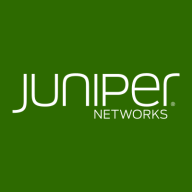

Find out what your peers are saying about Red Hat, Cisco, Broadcom and others in Network Automation.
| Product | Market Share (%) |
|---|---|
| Cisco DNA Center | 12.5% |
| Apstra Operating System | 1.7% |
| Other | 85.8% |

| Company Size | Count |
|---|---|
| Small Business | 10 |
| Midsize Enterprise | 9 |
| Large Enterprise | 25 |
The Apstra Operating System (AOS) is a turn-key automation solution that dramatically simplifies the process of designing, deploying and operating data center networks. Apstra AOS provides a singular view into the relationships and interdependencies of millions of data center elements. With real continuous validation, Apstra AOS enables you to instantly pinpoint and quickly resolve issues across all infrastructure silos, regardless of vendor or hardware.
Cisco DNA Center offers a comprehensive platform for network automation and management, providing detailed analytics, enhanced security, and streamlined operations for both wired and wireless networks.
Cisco DNA Center integrates with Cisco infrastructure to deliver efficient network automation and management, helping organizations improve network visibility, security, and control. It supports AI-driven analytics and automated workflows to enhance operational efficiency and reduce errors. Challenges include compatibility with third-party systems, steep learning curve, and complex deployment. Its interface facilitates centralized control, vital for troubleshooting, policy management, and configuration management, with support for zero-touch provisioning and SD-Access.
What are the key features of Cisco DNA Center?In sectors such as healthcare, finance, and retail, Cisco DNA Center is utilized for its ability to enhance security and compliance, manage large-scale networks, and provide detailed analytics for better operational decision-making. Its support for location tracking and policy automation ensures efficient network management across diverse environments.
We monitor all Network Automation reviews to prevent fraudulent reviews and keep review quality high. We do not post reviews by company employees or direct competitors. We validate each review for authenticity via cross-reference with LinkedIn, and personal follow-up with the reviewer when necessary.